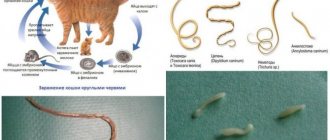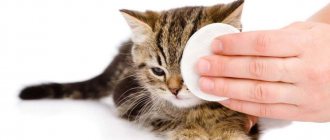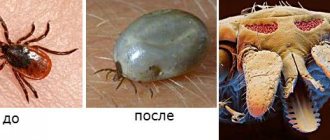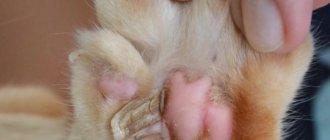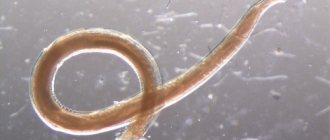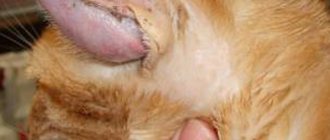One of the most common diseases that more than 80% of cats encounter throughout their lives is helminthiasis. They are characterized by a long and protracted course, and also have a wide range of clinical manifestations. Parasitic diseases occur not only in street cats, but also in domestic cats.
Read on to learn how to recognize a worm infection in your pet, what measures need to be taken, and whether parasites are dangerous for humans.
Read in this article
- Types and routes of infection
- Signs and symptoms
- Diagnostics
- How dangerous are worms?
- Is there a danger to humans? Probability of infection
- Anti-worm medications Tablets
- Suspensions
- Drops
- Injections
Types and routes of infection
Worms in cats can be round, tape or flat. The most common are roundworms and toxocaras, growing up to 3-5 cm in length. They are localized and multiply in the small intestine. Less commonly, hookworms (no more than 2 mm), heartworms and heartworms are detected in cats. They affect the intestines, lungs, muscles and cardiovascular system.
The most common routes of infection:
- drinking milk from an infected mother cat,
- eating small rodents (mice, rats, etc.),
- ingestion of worm eggs (for example, with dust and dirt from the soles of shoes),
- contact with other infected animals.
Infection with parasites is possible at any time of the year, but most often pets become infected in spring and summer. This is due to the fact that the most favorable conditions arise for the reproduction of helminths and the spread of their eggs. During this period, traveling with a cat to the country or hunting birds can cause infection.
“Real” lungworms in cats
Today, biologists and veterinarians believe that three types of lungworms can be found in these animals:
- Aelurostrongylus abstrusus (causes a disease called elurostrongylosis). The most “feline” parasite, since it is the one that can most often be found in representatives of the cat family. Its prevalence is largely due to the huge number of intermediate hosts: the larvae of the parasite can be found in the body of a variety of “small things”, ranging from amphibians and reptiles to birds. It is not surprising that veterinarians identify cases of infection not only here, but throughout the world. Thus, studies conducted by German veterinarians in 1997 showed that approximately 21% of all rural cats are carriers. Interestingly, many animals either do not have any special clinical signs, or they are too vague and weak for animal owners to contact a veterinarian.
- Capillaria aerophilia. Unlike both related species, these worms do not require intermediate hosts at all. It is enough for a cat to simply swallow the eggs of the parasite. Even 10-15 years ago, it was believed that this type of worm was found exclusively in North America, but the processes of globalization were not in vain: there is already information about infestations in our country. However, many biologists and parasitologists believe that globalization has nothing to do with it. It is very likely that the parasite entered the territory of the former USSR along with raccoon dogs imported from America.
- Paragonimus kellicotti. Least likely option. The fact is that the parasite is specific to the canine family, but occasionally it can be found in the body of cats (but this does not happen often). In addition, only (!) freshwater mollusks, and sometimes crayfish, act as intermediate hosts, which makes the prospect of infection of a domestic cat quite unlikely. In addition, parasite eggs (in huge quantities) are usually found when examining the feces of wild raccoons and raccoon dogs. It was with them that the worm entered the territory of our country, where it had never been encountered before.
We recommend reading: How Calcivirosis is Transmitted
All parasites of this type have one thing in common: all these worms need an intermediate host to develop. Infection occurs only when it is eaten by a cat. Mollusks, including land snails and even slugs, usually act as “incubators.” Of course, cats rarely eat such “tasty” game, but the same snails may well be eaten by rats or mice. And cats hunt small rodents, and they do it very actively!
Signs and symptoms of helminthic infestation
It is difficult to recognize helminthiasis. If large individuals (5-10 cm) can be seen in feces, then small ones (up to 1-2 cm) go unnoticed. Note : in appearance, worms are long white “laces” curled into a tight knot.
You can identify helminthiasis in your cat by a number of signs:
- swollen belly (tight, full, barrel-shaped),
- digestive and stool disorders (recurrent vomiting, diarrhea, constipation),
- rare single but severe cough,
- appetite disorders,
- blood in the stool,
- dullness and matting of fur,
- increased licking of the area under the tail,
- rolling on the floor due to itching in the anal area,
- in especially severe cases, the pet becomes lethargic and depressed.
One of the signs of helminthiasis is anemia. Accumulating in the pet’s body, parasites adhere to the intestinal walls and provoke severe bleeding. Anemia in an animal can be determined by its gums: in a healthy cat they are pink, but in a pet with parasites they are white or grayish.
Have you noticed one or more signs of worm infestation in your pet? Do not hesitate - seek professional veterinary help at a veterinary clinic. Only an experienced specialist will be able to determine the type of parasites and prescribe an effective course of treatment.
Lungworms in cats: life stage of roundworms
There are not so many “purebred” pulmonary parasites in our country: basically, they are found en masse in regions with hotter and more humid climates. But in our area there are often cases of ascariasis, i.e. helminthic diseases caused by parasitic nematodes. In 90% of cases they are mistaken for “pulmonary” worms.
It's all about the peculiarities of the life cycle of parasitic roundworms. Their larvae, once in the digestive tract of the final host, do not remain there for a long time. Young parasites gnaw through the intestinal walls, reaching local blood vessels. The larva, having broken through the wall of the latter, ends up in the general bloodstream. Its target is the pulmonary alveoli (however, along the way, the larvae often end up in completely different organs and tissues).
The larva spends about three weeks in the lungs. At this time, the parasite actively feeds on the pulmonary epithelium and blood, develops and grows. When the time comes, the worm’s body begins to secrete caustic and “burning” substances that irritate the delicate lung tissue. As a result, the animal develops a severe cough. Together with the expectorated mucus, the larvae again enter the animal’s gastrointestinal tract, and this time they remain there for growth and development.
But two or three weeks spent by growing parasites in the lungs does not have the best effect on the animal’s health. In particular, young pets often develop severe bronchitis or even pneumonia after this.
But! Despite all of the above, ordinary parasitic nematodes do not live permanently in the lungs and bronchi, since for them this time is a short stage of development.
At the same time, there are “full-fledged” lungworms that constantly live in the lumen of the respiratory system.
Diagnostics
The first stage of treatment is the diagnosis of helminthiasis. It is aimed at determining the type of parasites, since further treatment depends on their characteristics. In a veterinary clinic, various methods are used to diagnose helminthiasis.
Among them:
- stool analysis,
- sputum analysis,
- X-ray examination of the thoracic region,
- ultrasonography,
- blood analysis.
After diagnosis, a course of treatment and specific medications are prescribed, aimed at destroying and removing parasites from the animal’s body, as well as relieving symptoms that arise.
How dangerous are worms?
Helminths seriously weaken the cat’s body, slowly depleting it. In advanced cases, in particular if left untreated, severe infection can lead to the death of the pet due to clogging of the intestines with lumps of parasites.
Worms provoke:
- loss of appetite,
- sudden weight loss in the pet (especially in the spine area),
- disruption of the digestive system,
- weakening of the immune system, etc.
To avoid these consequences, it is necessary to regularly carry out deworming, and at the first signs of infection, seek help from a veterinarian.
Is there a danger to humans? Probability of infection
About 32 varieties of worms can live in a cat’s body, which pose a danger to human health. The main cause of infection is non-compliance with hygiene rules. When feeding a cat by hand or playing with it, parasite eggs land on the skin of the hands and then penetrate into the oral cavity.
In addition, worms can enter the human body by touching surfaces on which eggs remain (for example, a tray).
The danger of infection with worms for humans (without proper treatment):
- enterobiasis,
- Iron-deficiency anemia,
- dyspeptic disorders (heartburn, diarrhea, etc.),
- damage to internal organs, etc.
To avoid dangerous consequences, it is necessary to regularly examine your pet, and if the first signs of helminthiasis occur, seek veterinary help. The specialist will conduct a thorough diagnosis of the cat’s condition and tell you whether they are dangerous to the human body.
Lungworms in cats (trematodiasis)
In this group, the most common disease is opisthorchiasis, which is caused by the cat (Siberian) fluke. Cats become infected if they regularly eat fresh catch of carp fish raw. Parasites attach to the liver with suckers and damage it, penetrating the bile ducts and pancreatic ducts.
Cats get quite seriously ill with fever, vomiting with bile, sometimes there is a perversion of appetite, and a icteric coloration of the mucous membranes appears. There is little that can be done with tablets alone; it is advisable to carry out complex therapeutic measures in a veterinary institution.
Medicines for worms
External and internal drugs are used to treat helminthiasis. They not only eliminate the signs of the disease (diarrhea, bleeding, digestive disorders, etc.), but also help to completely get rid of parasites.
It is strongly recommended to abandon traditional methods in the treatment of helminthiasis. Remember that only after diagnosis and a complete examination can your pet be prescribed anthelmintic drugs.
Drug formats:
- pills,
- drops,
- suspensions,
- solutions for injections.
The veterinarian prescribes single-component drugs, as well as broad-spectrum drugs. The latter are aimed at destroying different types of parasites at the same time. Keep in mind that drugs and their dosage are prescribed by a specialist in each specific case individually.
Pills
Tablets are the most common format of drugs used in the treatment of helminthiasis. They are crushed and then added in crushed form to your pet's food or dissolved in water. Among the most effective drugs in tablet form:
- Polyverkan,
- Kanikvantel,
- Milbemax,
- Drontal,
- Dirafen,
- Alben.
Suspensions
To remove worms from a cat, various suspensions are also used. They need to be given to the pet through a special dispenser syringe (orally), and then after 6-8 hours you need to give activated charcoal. This is the most optimal solution for kittens 3-4 months old.
Among the most popular suspension preparations:
- Dirofen,
- Prazicide,
- Pirantel,
- Prazitel.
Drops
Another convenient and effective format of anti-parasite medications for cats is drops. Usually they have a complex effect, so they cope not only with worms, but also with other problems (fleas, lice, ticks, etc.). They must be applied to the withers, since there the cat will not be able to lick them off.
Among the most effective drops are:
- Dironet,
- Bars spot-on,
- Advocate,
- Stronggold,
- Profender.
Injections
In the treatment of helminthiasis, not only tablets, drops and suspensions are used, but also injections. They are more effective, but keep in mind that each time you will need to go to a veterinary clinic. It is strongly not recommended to give injections to your pet at home.
Among the most effective injection drugs:
- Novomek,
- Barmek,
- Ivomek.
Runny nose from parasites
- 1 What parasites cause a runny nose? 1.1 Mechanism of action of helminths
- 1.2 Associated symptoms of infestation
OUR READERS RECOMMEND!
Our readers successfully use Intoxic to get rid of parasites. Seeing how popular this product is, we decided to bring it to your attention. Read more here...
Very often in their lives people encounter helminths and ailments caused by their life activities. Often there may be snot due to worms and in the presence of other types of parasitic organisms. There are more than a dozen parasites that can cause a prolonged runny nose in adults and children. How to find out about the presence of helminths in the nasopharynx, and is it possible to cure snot due to parasites?
What parasites cause a runny nose?
Worm diseases provoke disturbances in the functioning of internal organs, cause a lot of unpleasant symptoms and prevent a person from living a normal life. Most parasitic organisms are localized in the intestines, but some species are able to migrate throughout the body and settle in hard-to-reach places. These species include roundworms and lamblia.
Even a newborn child can become infected with a disease such as ascariasis. Infection with worm larvae occurs from an infected mother during pregnancy. A child with this problem is highly susceptible to colds and allergic reactions, is very capricious and is in constant anxiety.
Parasitic helminthic infestations of Giardia can affect the nasopharynx, causing the appearance of snot and difficulty breathing. In some eastern countries, larvae of flies, and less often of gadflies, often settle in the noses of local residents. They are localized on the damaged mucous membrane of the nasal sinuses, provoking copious discharge of snot and blood from the nose, headache, and general malaise.
Return to contents
Mechanism of action of helminths
Swelling of the nasopharynx may be caused by the activity of parasites in the nasal mucosa.
The appearance of acute and chronic rhinitis, as well as nasal congestion, is caused by roundworms and lamblia. Parasite larvae penetrate many human organs, including the nasopharynx. Settling in the nasal mucosa, the normal life activity of parasites occurs - development, nutrition and reproduction. This leads to severe swelling of the inner lining of the nose and, as a consequence, to a protracted inflammatory process.
Return to contents
Associated symptoms of infestation
The main signs of the appearance of roundworms and lamblia in the nasopharynx are:
- Redness of the external nasal sinuses, the skin peels in places.
- Dizziness and headache.
- Unreasonable increase in body temperature.
- Heavy breathing. There is a feeling of lack of air.
- Red itchy rashes appearing on the surface of the skin and in the corners of the mouth.
- The appearance of pain and burning in the eyes.
Return to contents
Diagnostics
The cause of rhinitis can be determined only after undergoing the recommended tests and research. These include:
- Blood chemistry. It is prescribed without fail to exclude possible internal diseases.
- Analysis of stool for bacteriological culture (determining the presence of parasitic forms in the stool).
- General urine analysis. An analysis is taken to examine urine for the presence of bacteria, fungi and larvae.
- Endoscopic examination (rhinoscopy) - examination of the nasal septum for integrity, examination of the surface of the mucous membrane for the presence of tumors and inflammation.
- If necessary, x-ray of the paranasal sinuses. X-rays are performed to identify foreign bodies and malignant tumors in the nose.
Return to contents
Treatment methods
Antihelminthic drugs should be taken only as prescribed by a doctor, as they reduce immunity.
The most common medications for worms are Pirantel, Helmintox, Nemozol. They have the fewest side effects and are prescribed by doctors for the treatment of adults and children. In case of severe infection with worms, more effective drugs are used, such as Biltricid, Levamisole. They are more toxic compared to Pirantel and its analogues. The recommended dosage of the medicine is determined according to the age of the patient. Children are allowed to be given some antihelminthic drugs starting in infancy. Such drugs include Piperazine.
Among the folk methods of treating worms, there are many antihelminthic herbal decoctions, anthelmintic products (garlic, pumpkin seeds) and other methods of getting rid of parasites. Folk remedies are mainly used for prevention. The main treatment is best carried out with the help of medications under the supervision of a doctor; it is considered more effective and safe.
Before starting therapy, it is necessary to accurately determine the cause of the snot. It is important to make sure that the illness began precisely because of worms, and is not a consequence of a respiratory disease. Having passed the recommended tests and conducted research, the attending physician will select the right medicine, the action of which is aimed at eliminating the causative agent of the disease. Following medical recommendations will allow you to quickly and painlessly get rid of the unpleasant condition and destroy helminths.
Prevention of helminthiasis
Try to do everything you can to prevent your pet from becoming infected. A number of preventive recommendations developed by veterinarians will help you with this. These include a ban on feeding raw fish and meat. The food must first be frozen, but it is best to boil it.
Prevention:
- Regularly change the bedding on which the pet lies, since parasite eggs can also remain on it;
- Keep the cat's litter box clean and change the litter frequently. It is recommended to disinfect the toilet 1-2 times a week;
- Preventive deworming should be carried out every 3-4 months, especially for cats that go outside;
- It is recommended to leave outdoor shoes and clothing in places that are inaccessible to the cat, since they can carry helminth eggs.
Helminthiasis is an unpleasant problem, but with the right approach it can be quickly resolved. The main thing is to promptly recognize the disease and treat the cat using various medications (tablets, drops, suspensions, etc.). After completing treatment, do not forget about prevention. Get dewormed and checked by a veterinarian regularly!
